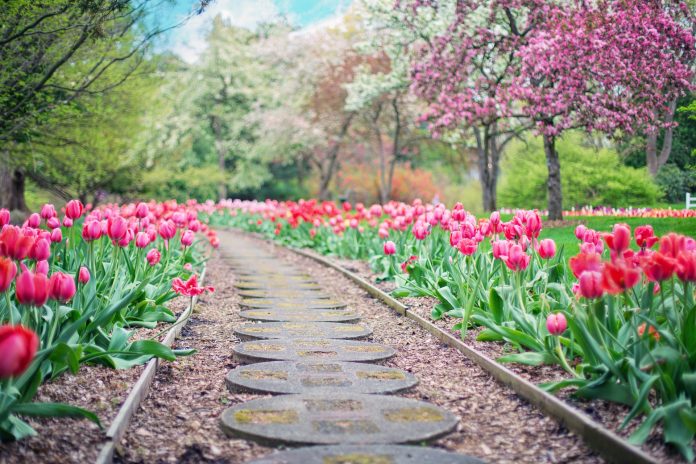For many, the onset of spring brings seasonal allergies in its train. Also, as a story in the Boston Globe demonstrates, spring delivers an annual supply of stories blaming climate change for initiating earlier, more severe allergies. What the Boston Globe and other media outlets ignore, however, is the fact that the earlier arrival of flowering plants and trees reflects a net benefit of climate change; a greening of the earth and expanded growing season, rather than a net negative, despite the impact on allergy suffers.
A story by the Boston Globe’s climate producer, Dharna Noor, titled “Allergies hitting early? Climate change may be to blame, report says,” reports on a new study which claims climate change is making allergy season “more brutal.” Studies like this are reported almost every spring.
“As the world warms as a result of burning fossil fuels, winters across much of the United States are getting shorter and springs longer, giving plants more time to grow, flower, and release pollen,” writes Noor. “In other words, allergy season is lengthening thanks to climate change, and the Wednesday analysis by climate research nonprofit Climate Central found exactly by how much: 15 days on average since 1970.”
So a study produced by a climate activist group is being touted by a climate producer who previously served as a staff writer at Earther, a climate alarm hyping journal published by Gizmodo. Is anyone besides me not surprised by the alarming and one-sided nature of the reporting?
To be fair, it is almost certainly true that allergy sufferers are paying a price for the later arrival of winter and its earlier end as a result of modest nighttime warming. Untreated allergies can seriously hamper peoples lives and lifestyles. That is a downside to the recent warming trend.
What this annual parade of “allergy worsening/climate change the cause” stories routinely downplay or ignore entirely, is the upside: longer growing seasons and a greener earth. An author of the study that Noor quotes, Climate Central meteorologist Lauren Casey, succinctly makes the connection but fails to expand on its broader impact.
“Plants use carbon dioxide and photosynthesis,” Casey said. “They take that carbon dioxide and transform it into energy.
“So you see more plant growth which means more pollen,” said Casey.
You got that: More carbon dioxide improves photosynthesis, which leads to more plant growth! That is hardly a bad result even if it does have the deleterious secondary effect of producing more pollen and exacerbating allergies.
As Climate Realism has pointed out repeatedly in previous years when spring’s arrival heralded by a flood of stories describing the impact of spring on allergy suffers, here, here, and here, greening is a good thing, not a bad one.
NASA’s satellite measurements show the “longer, warmer growing seasons caused by climate change,” along with more atmospheric carbon dioxide, are spurring a tremendous greening of the Earth. NASA reports these factors have produced a 10 percent increase in global plant life across the past 20 years.
These expanding, lusher ecosystems are good for pollinators, animals, and humans. Both crop and non-crop plants evolved when carbon dioxide levels were much higher than today and do better (grow faster and larger) as carbon dioxide levels increase. Thousands of experiments and the actions of agronomists, botanists, and greenhouse operators worldwide confirm this.
One study involving 32 researchers representing nine countries, published in Nature Climate Change, using three long-term satellite-derived leaf area index (LAI) records and 10 global ecosystem models from 1982 through 2009, found “a persistent and widespread increase of growing season integrated LAI (greening) over in 5% to 50% of the global vegetated area, whereas less than 4% of the globe shows decreasing LAI (browning).” The study traced this global greening directly to the carbon dioxide fertilization effect, reporting that it explains 70% of the observed greening. Satellites show areas of desert are being reclaimed by vegetation as carbon dioxide levels have increased.
In addition, people generally spend more time outdoors and exercise more in warmer weather. This does expose people to pollen which can exacerbate some allergies, however, such activities also produce obvious health benefits.
Carbon dioxide and longer growing seasons have also dramatically boosted crop production. New crop production records have been recently and repeatedly set for cereal grains, fruits, tubers, and vegetables, as the Earth modestly warms.
The downside of lusher, more abundant plant growth is that the increased pollen emitted means harder times for allergy sufferers. In the end, even if climate change is making allergy seasons “more brutal,” in Noor’s words, most people, including many allergy sufferers, would likely consider this a small price to pay for a greener world with more food and less hunger.
Focusing on a drawback of a greener world, worsening allergies, while ignoring its broad benefits of more trees, shrubs, grasses, flowers, and food crops, represents poor journalism.
















In the absence of accurate reporting, we are left with poor journalism, largely driven by a narrative support imperative.